233 DOG-LOVING MONARCH
OUR COUNTRY-LOVING DOG-LOVING MONARCH
by David Hancock
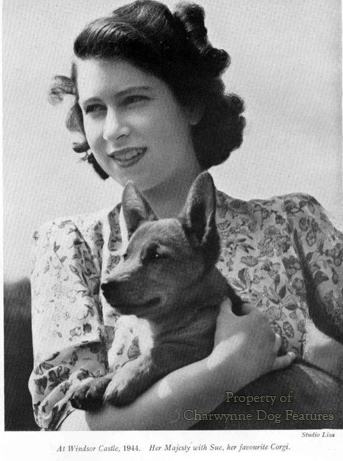 In times when often misdirected environmental awareness and misapplied moral vanity can combine to overwhelm or outflank genuine country-lovers, it is comforting to have a monarch who has steadfastly sustained her enlightened understanding and wholehearted support for country events. In an age when Prince Charles's mentor, the well-travelled philosopher Laurens Van der Post, has stressed the threat to civilised living of what he terms 'townmindedness', the Queen has passed on to her children her own deep-rooted affection for the countryside. In an era when what has been described as the 'Walt Disney' view of country ways increasingly prevails, the Queen is a shining example of how to be pro-countryside without being anti- countryman. She has also been steadfastly pro-dog for over half a century.
In times when often misdirected environmental awareness and misapplied moral vanity can combine to overwhelm or outflank genuine country-lovers, it is comforting to have a monarch who has steadfastly sustained her enlightened understanding and wholehearted support for country events. In an age when Prince Charles's mentor, the well-travelled philosopher Laurens Van der Post, has stressed the threat to civilised living of what he terms 'townmindedness', the Queen has passed on to her children her own deep-rooted affection for the countryside. In an era when what has been described as the 'Walt Disney' view of country ways increasingly prevails, the Queen is a shining example of how to be pro-countryside without being anti- countryman. She has also been steadfastly pro-dog for over half a century. 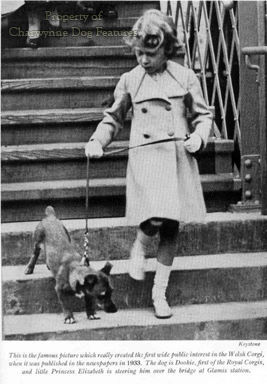
Her attitude towards country sports, her support for sporting and working dog activities, as well as her evident affection for her own dogs, are manifestations of this commitment. When presenting prizes at retriever trials at Sandringham or at sheepdog trials near Balmoral, the Queen looks not only thoroughly at home but as though she is really enjoying the experience. The fact that she is rarely seen informally at home without her dogs and that her favoured dogs come from a working breed are both significant.
Down the years, the close association of successive generations of the royal family with dogs has been very apparent; youare much more likely to see a family photograph of them in which their dogs feature prominently than not. This long association has been with both sporting and working breeds, as the dogs of the present royal family exemplify today. Predictably, royal patronage has led to certain breeds becoming much more popular, with the Welsh corgi being a classic example. From being a nondescript little-known cattle- herding breed to being appreciated throughout the world as a busy bossy little canine character is entirely due to royal interest in the breed in Britain. 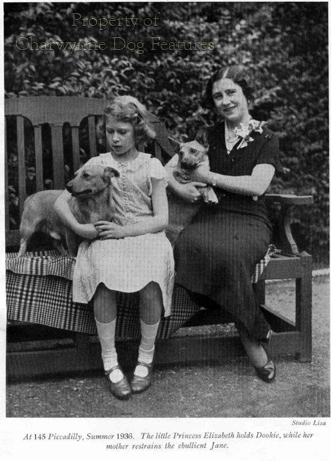
This interest started when King George VI, when Duke of York, bought the original royal corgi in 1933 after seeing and admiring a friend's dog of this then less than well known breed. This first corgi was the celebrated Dookie, a Pembrokeshire Welsh corgi from the much-respected Rozavel kennels in Surrey. Three years later the King acquired another one, this time a bitch called Jane, which had puppies on Christmas Eve in 1936. Two of this litter, Crackers and Carol, were kept and Princess Elizabeth grew up with these dogs, admiring their indomitable spirit and strong-willed ways. In 1944, Princess Elizabeth was given a corgi of her own, a bitch called Susan, from kennels in Cambridgeshire.
The Queen has subsequently bred from this and other bitches, using recommended stud-dogs from outside. The Queen Mother owned three corgis from this dynasty and Princess Anne one. The much-loved Susan died in 1959, having established a different sort of royal family! Not content with this, the Queen has opted for her own breed of dog, the 'dorgi'. Several times Her Majesty mated a corgi bitch with the late Princess Margaret's dachshund Pipkin to produce the hybrid dorgis. To favour a working breed hardly known at the time showed commendable individuality, but then to cross-breed using two different pedigree breeds! The conformists at the Kennel Club would never approve, but the result not surprisingly is more vigorous dogs. If only more people were to be less in awe of the over-rated pedigree. 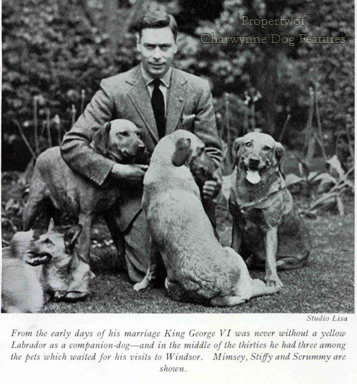
The Queen looks after her own dogs herself and they move with Her Majesty from house to house and live in her private apartments. When they die, they are buried in the grounds of whichever house the Queen is living in at the time. Three of the longest living corgis, Susan, Sugar and Heather, have their gravestones at Sandringham. The Queen is interested in the breeding of gundogs as well as corgis and dorgis, and is anxious to perpetuate field trial capabilities in her Sandringham Labradors. The old Sandringham kennels were demolished in 1968 and have been replaced by smaller wooden kennels with chain link fencing runs, able to accommodate up to 40 dogs. The Queen takes a very great interest in the kennels, as did Queen Alexandra long before her.
The Sandringham strain of black Labradors was founded by Queen Alexandra, who possessed many different breeds of dog, in 1911. But after her death in 1925, King George V changed the royal affix, registered with the KC, from Wolferton to Sandringham. He also reintroduced Clumber spaniels, originally installed by King Edward VII at Sandringham. Clumber Spaniels were favoured by the King because of their prowess in thick cover. Theyalso won several prizes at dog shows, including two firsts at Crufts. Now the working strain of this fine old breed is being favoured by Princess Anne, who owns one and allows the use of the Gatcombe Park estate for their working trials. 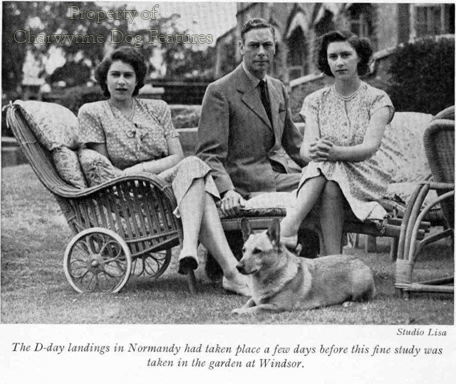
During the short reign of King Edward VIII, the kennels were closed and there were no dogs at Sandringham; as the Duke of Windsor he favoured toy dogs and took no part in country sports. But when King George VI came to the throne in 1936, much to the joy of the Sandringham keepers, he re-established the kennels in a small way with half a dozen yellow Labradors, which he used only in the shooting field. Then in 1949 it was decided that the famous Labrador dog Windsor Bob should be brought to Sandringham to build up the strain there once more. Since her accession to the throne in 1952, the Queen's sustained interest has ensured that the breeding programme has gone from strength to strength. One early result of this interest and support was the attainment of field trial champions Sandringham Ranger, Slipper, Sherry of Biteabout and her offspring Sandringham Sydney.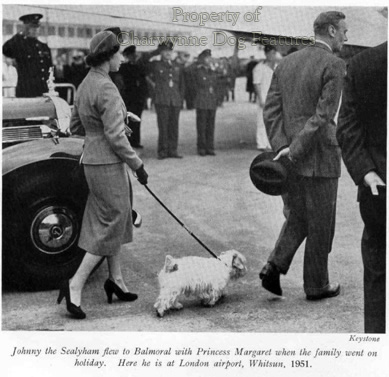
The kennels now mainly supply the royal family and their keepers with working gundogs, spaniels as well as Labradors, in the shooting field. All the puppies born at Sandringham are given a name by the Queen and registered at the Kennel Club under the kennel affix. It has long been the policy at these royal kennels to strive to reach the highest standards of trained gundog, with a great deal of time spent training the better dogs up to field trial standards. It is encouraging to learn of the Queen's grandchildren being introduced to country sports at an early age and to hear of their inherited interest.
The association between dogs and the royal family has been long and varied. When Henry the Eighth lost his spaniel, he rewarded the finder with five shillings, an appreciable sum in those times. Queen Elizabeth the First adored her 'singing' beagles and James the First sent home to Scotland for his terriers soon after ascending the English throne. The ill-fated Charles the First seldom walked out without the toy spaniels which bear his name to this day. Charles the Second was scolded by Pepys for "playing with his dogs all the while" and William the Third introduced the Pug here from Holland. Queen Victoria kept nine or ten different breeds, preferring Japanese Spaniels, Basset Hounds and Borzois. More recently the Duke of Kent's father owned a champion Great Dane called Midas and even took his Alsatian with him on his honeymoon with Princess Marina. 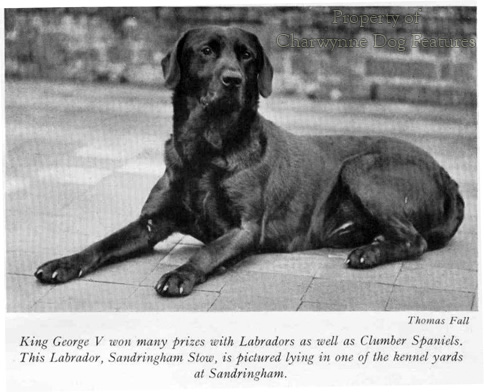
Down the centuries the royal family have shewn a sustained interest in dogs, favouring some breeds, introducing others to this country and making both sporting and working breeds very popular. In modern times we have a wide span of interest, with Her Majesty's example leading to Princess Anne favouring not just pedigree breeds like the Bull Terrier and the Clumber Spaniel, but a black and tan scenthound and, most eccentrically for such a person, a lurcher, a type of dog associated for centuries with those who rarely respected the Game Laws or the royal hunting privilege. Prince Charles is often seen in Scotland with his Russell-type terriers and has now learned for himself how their hunting instincts can sadly lead to their getting lost, usually down some delicious smelling hole. Princess Margaret once had a working Sealyham terrier, Ilmer Johnny Boy, from Sir Jocelyn Lucas's famous pack.
If Laurens Van der Post is right and 'townmindedness' does pose a considerable threat to the way we have traditionally lived then the example set by the Queen is going to be increasingly influential. Her evident love of the countryside and her support for sporting and working dog events is comforting. For a nation famed all over the world for its hounds, terriers and gundogs to have at its head a sincere admirer of dogs with some purpose in life is both appropriate and reassuring. A nation of dog-lovers ruled by a dog-loving monarch; may the situation continue for another eighty years!